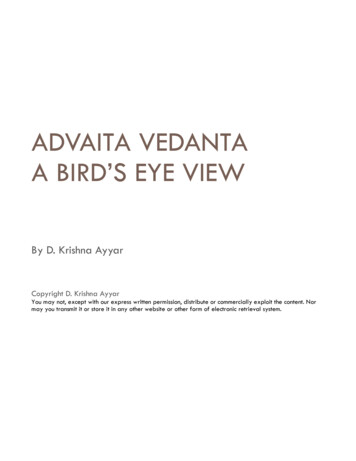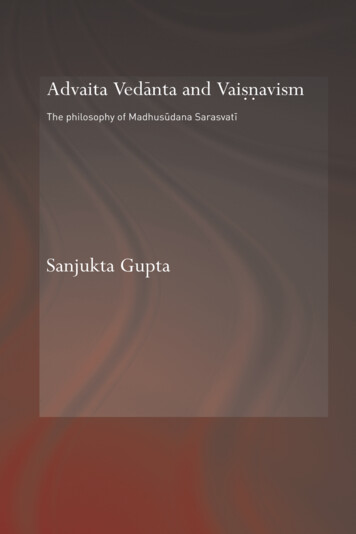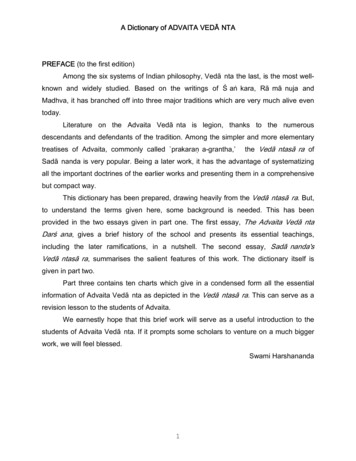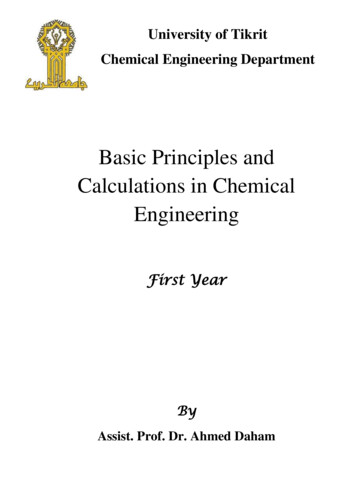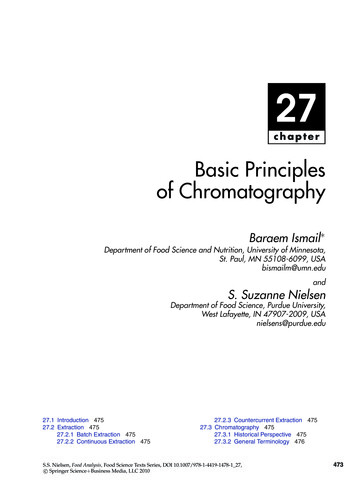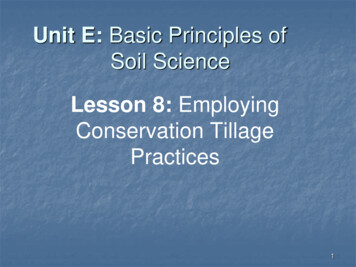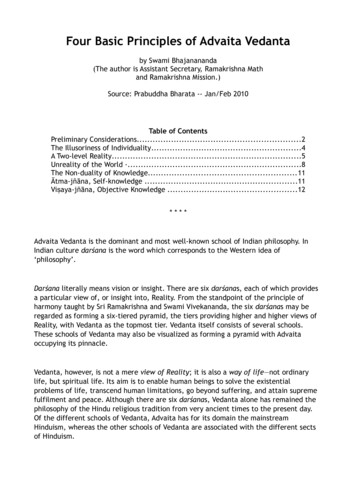
Transcription
Four Basic Principles of Advaita Vedantaby Swami Bhajanananda(The author is Assistant Secretary, Ramakrishna Mathand Ramakrishna Mission.)Source: Prabuddha Bharata -- Jan/Feb 2010Table of ContentsPreliminary Considerations.2The Illusoriness of Individuality.4A Two-level Reality.5Unreality of the World ·.8The Non-duality of Knowledge.11Ātma-jñāna, Self-knowledge .11Viṣaya-jñāna, Objective Knowledge .12****Advaita Vedanta is the dominant and most well-known school of Indian philosophy. InIndian culture darśana is the word which corresponds to the Western idea of‘philosophy’.Darśana literally means vision or insight. There are six darśanas, each of which providesa particular view of, or insight into, Reality. From the standpoint of the principle ofharmony taught by Sri Ramakrishna and Swami Vivekananda, the six darśanas may beregarded as forming a six-tiered pyramid, the tiers providing higher and higher views ofReality, with Vedanta as the topmost tier. Vedanta itself consists of several schools.These schools of Vedanta may also be visualized as forming a pyramid with Advaitaoccupying its pinnacle.Vedanta, however, is not a mere view of Reality; it is also a way of life—not ordinarylife, but spiritual life. Its aim is to enable human beings to solve the existentialproblems of life, transcend human limitations, go beyond suffering, and attain supremefulfilment and peace. Although there are six darśanas, Vedanta alone has remained thephilosophy of the Hindu religious tradition from very ancient times to the present day.Of the different schools of Vedanta, Advaita has for its domain the mainstreamHinduism, whereas the other schools of Vedanta are associated with the different sectsof Hinduism.
Four Basic Principles of Advaita Vedanta -- Swami BhajananandaPreliminary ConsiderationsBefore taking up a study of the basic principles of Advaita Vedanta it is necessary tokeep in mind two points. One is the distinction between Advaita as an experience andAdvaita as a philosophy.As a direct transcendental spiritual experience, Advaita marks the highest point ofspiritual realization a human being can attain. In that climactic experience thedistinction between the individual and the cosmic is lost, and the distinctions betweenthe knower, the thing known, and knowledge disappear. It is ‘Advaita as experience’ thatforms the main theme of the Upanishads.‘Advaita as a philosophy’ is a conceptual framework that attempts to explain how theimpersonal Absolute appears as the phenomenal world and individual selves. Thetwelfth-century Advaita writer Sriharsha says in the introduction to his famous workKhandana-khanda-khadya that the purpose of philosophy, śāstrārtha, is to determine thenature of truth, tattva-nirṇaya, and victory over the opponent, vādi-vijaya. AcharyaShankara himself devotes a considerable part of his commentaries to refuting the viewsof opponents. In the present article we confine our discussion to the philosophicalaspect of Advaita.The second point to be kept in mind is that, although Advaita philosophy is built on theimmutable and indestructible foundation of timeless truths and laws, its superstructureof concepts underwent several changes during different periods in the history ofHinduism. Four main phases may be seen in the development of Advaita philosophy.i)Advaita of the Upanishads · As stated earlier, this is the experiential aspect ofAdvaita.2
Four Basic Principles of Advaita Vedanta -- Swami Bhajananandaii)Advaita of Shankara · It is well known that the edifice of Advaita philosophy,which towers over all other systems of philosophy, was built by Acharya Shankara in theeighth century. Shankara’s main endeavour was to establish the non-dual nature ofBrahman as the ultimate Reality. His most original contribution, however, was theintroduction of the concept of a cosmic negative principle known as māyā or ajñāna,ignorance, in order to explain the origin of the universe and the existence of duality inthe phenomenal world without affecting the non-dual nature of Brahman.iii)Post-Shankara Advaita · This phase extends over a long period, from the ninthcentury to the sixteenth. The writers on Advaita Vedanta of this period include eminentthinkers like Padmapada, Sureshwara, Vachaspati, Prakashatman, Vimuktatman,Sarvajñatman, Sriharsha, Chitsukha, Madhusudana, and others, who added several newconcepts into the philosophical framework of Advaita Vedanta. During this period AdvaitaVedanta split into three streams or schools. These are: (a) the Vartika school, based onthe views of Sureshwara; (b) the Vivarana school, based on the views of Padmapada andPrakashatman; and (c) the Bhamati school, based on the views of Vachaspati Mishra. Thephilosophy of Advaita underwent great refinement and intellectual sophistry during thepost-Shankara phase. However, the focus of discussions shifted from Brahman to māyā orajñāna.iv)The Modern Phase of Advaita · The modern phase in the developmnt of AdvaitaVedanta was inaugurated by Sri Ramakrishna and Swami Vivekananda. They introducedseveral important changes in the understanding of Advaita in order to make it morerelevant to the needs and conditions of the modern world. Some of the changes broughtabout by them are briefly stated below.(a)The experiential aspect of Vedanta has come to be stressed, as it was during theVedic period, more than the philosophical aspect.(b)Harmony of the Advaitic view with the views of other schools of Vedanta has beenestablished by accepting all views as representing different stages in the realization ofBrahman. This has put an end to unnecessary polemical attacks and sectarian squabbleswithin the fold of Vedanta.(c)The older form of Advaita gave greater importance to the transcendent aspect ofBrahman, whereas the new view on Advaita gives greater importance to the immanentaspect.(d)Swami Vivekananda found immense practical significance for Advaita Vedanta insolving the individual and collective problems of day-to-day life. Swamiji has shown howAdvaitic knowledge can serve as the basis of morality, basis of inner strength andcourage, and as the basis for social justice and equality as well. Above all, Advaitaprovides the basis for Sri Ramakrishna’s message of ‘service to man as service to God’,śivajñāne jīva-sevā, which Swami Vivekananda popularized as the new gospel of socialservice. All the service activities of the Ramakrishna Math and Mission are inspired bythis gospel of service.3
Four Basic Principles of Advaita Vedanta -- Swami Bhajanananda(e)Swami Vivekananda has brought about the reconciliation of Advaita Vedanta withmodern science. Furthermore, Swamiji showed that Vedanta itself is a science—thescience of consciousness.(f )Swamiji isolated the universal principles of Advaita Vedanta from themythological, institutional, and cultic aspects of its parent matrix in Hinduism andconverted the universal principles of Advaita into a universal religion—which in themodern idiom means universal spirituality—for all humanity.The philosophical presuppositions and metaphysical underpinnings and implications ofthis ‘Neo-Vedanta’, which is better called ‘Integral Vedanta’, are yet to be worked out,or even studied, properly. Everything goes to show that the principles of Vedantadeveloped by Swami Vivekananda are likely to have a great impact on world thought,global culture, and human progress in the coming decades and centuries of the thirdmillennium.The aim of the present article is to explicate the main principles of Advaita Vedantadeveloped during the post-Shankara period. A proper understanding of these basicprinciples is necessary to understand and evaluate the status, influence, and possibilitiesof Vedanta in the modern world and the contributions made to it by Sri Ramakrishna andSwami Vivekananda.Post-Shankara Advaita Vedanta rests on four foundational principles:(i)(ii)(iii)(iv)the illusoriness of jīvatva, individuality;a two-level reality;ajñāna as the conjoint cause of the world; andthe non-duality of Consciousness.The Illusoriness of IndividualityBy Advaita is meant the non-duality of Brahman, or rather the denial of duality inBrahman. The central concept of Vedanta darśana is that Brahman is the ultimate causeof the universe and the ultimate Reality. This is accepted by all schools of Vedanta—dualistic as well as non-dualistic. What then is the difference between Dvaita andAdvaita? One basic difference is that according to dualistic schools individuality is realand persists even in the state of mukti, whereas in Advaita individuality is unreal anddoes not persist in the state of mukti. Shankara says: ‘What is called jiva is notabsolutely different from Brahman. Brahman itself, being conditioned by adjuncts suchas buddhi, intellect, and the like, comes to be called “doer” and “experiencer”. ’1 ‘Thedifference between the individual self and the supreme Self is due to the presence oflimiting adjuncts, such as the body, which are set up by names and forms and arecreated by avidyā; there is actually no difference.’2 In the dualistic schools the word1 Na hi jīvo nāmātyanta-bhinno brahmaṇaḥ buddhy- ādy-upādhi-kṛtaṁ tu viśeṣam-āśritya brahmaivasan-jīvaḥ kartā bhoktā cety-ucyate. Shankaracharya’s commentary on Brahma Sutra, 1.1.31.2 ita- nāmarūpa-racita-dehādy-upādhinimitto bhedo na4
Four Basic Principles of Advaita Vedanta -- Swami Bhajanananda‘Atman’ is used to refer only to the individual self, and not to Brahman.When the Atman identifies itself with mind and body, it is called jiva. In the state ofmukti this identification disappears, but the Atman, although it becomes almost similarto Brahman, remains distinct and separate from Brahman. Here, the relationshipbetween Atman and Brahman is an organic relationship, like that between the part andthe whole. The type of difference that exists between Brahman and the individual selvesis known as svagata-bheda.3Advaita denies svagata-bheda in Brahman. According to Advaita, in the state of muktithe Atman does not remain distinct from Brahman but becomes one with it. In fact,there is no distinction between Atman and Brahman; as soon as the identification withmind and body disappears, the distinction between Atman and Brahman also disappears.Hence, Advaitins use the terms Atman and Brahman interchangeably.We may conclude this section with a statement made by Krishnachandra Bhattacharya,one of the original thinkers and great scholars of Indian philosophy of the twentiethcentury: ‘The illusoriness of the individual self is apparently the central notion ofAdvaita Vedanta. Every vital tenet of the philosophy—Brahman as the sole reality, theobject as false, Māyā as neither real nor unreal, Iśvara as Brahman in reference to Māyā,mokṣa (liberation) through knowledge of Brahman and as identity with Brahman—may beregarded as an elaboration of this single notion.’4A Two-level RealityThe most crucial problem in Advaita Vedanta is to explain the coexistence of twoentirely different and incompatible entities, Brahman and the world. Brahman is infiniteConsciousness, which is nirguṇa, absolutely devoid of all attributes. What Brahman iscannot be expressed in words. The Upanishadic definition ‘Brahman is Truth, Knowledge,pāramārthikaḥ (1.4.22).3 In treatises on Vedanta three kinds of bheda, difference, are mentioned: (i) Vijātīya-bheda: thedifference between objects of different kinds or species; as for example the difference between a treeand a cow. The difference between Purusha and Prakriti in Sankhya philosophy is of this kind.The difference between God and the souls in the Judeo-Christian and Islamic traditions is also of thiskind. Just as the potter and the pot can never be the same, so also the Creator and creature can neverbe the same. This is not the type of difference between the individual Self and the Supreme Selfaccepted in Dvaita schools of Vedanta. (ii) Sajātīya-bheda: the difference between objects of the samekind or species; as for instance the differences between two mango trees. The difference between twoPurushas in Sankhya philosophy, and the difference between two liberated selves in Ramanuja’sphilosophy, are of this type. (iii) Svagata-bheda: the differences found among the parts of the sameobject; as for instance the difference among the branches, leaves, and flowers of a mango tree, or thedifferences between rind, pulp, and seeds of a bel fruit. This is the type of difference between Atman,the individual Self, and Brahman in the dualistic schools of Ramanuja, Madhva, and others. This kind ofdifference is necessary for the soul to adore and love God and enjoy the bliss of Brahman. But Shankaradenies even svagata-bheda in Brahman; according to him the individual Self attains oneness withBrahman, so much so that it becomes Bliss itself.4 Krishnachandra Bhattacharya, ‘The Advaita and Its Spiritual Significance’, in The Cultural Heritage ofIndia, 7 vols (Kolkata: Ramakrishna Mission Institute of Culture, 2001), 3.245.5
Four Basic Principles of Advaita Vedanta -- Swami BhajananandaInfinity’5 is only a symbolic indicator, lakṣana, not a true description, of the real natureof Brahman. The infinite, the indivisible, the attributeless cannot be characterized interms of finite categories.As Sri Ramakrishna used to say, ‘Brahman is the only thing which has never becomeucchiṣṭa, that is, defiled by human mouth’. Brahman is the sole Reality. The Upanishadsdeclare: ‘All this is Brahman’; ‘There is no multiplicity here.’6However, the Upanishads and Brahma Sutra also rega
Advaita Vedanta is the dominant and most well-known school of Indian philosophy. In Indian culture darśana is the word which corresponds to the Western idea of ‘philosophy’. Darśana literally means vision or insight. There are six darśanas, each of which provides a particular view of, or insight into, Reality. From the standpoint of the principle of harmony taught by Sri Ramakrishna and .
